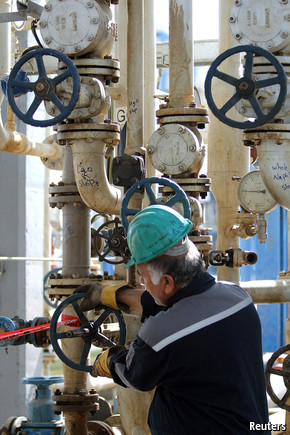by The economist
Commodity-trading houses are growing—and running more risks
| BANKS, harried by regulators and short of capital, are fleeing the commodities business. Deutsche Bank, Morgan Stanley and UBS either shuttered or shrank their commodities operations last year; this year Barclays, Credit Suisse and JPMorgan Chase have scaled back. But even as they retreat, commodity-trading houses, most of which began life as simple middlemen, are getting ever more deeply involved in the extraction, shipping and refining of raw materials. The buyer of JPMorgan Chase’s physical commodities unit, for instance, was Mercuria, a ten-year-old firm based in Switzerland that started out trading oil but now owns (or has joint ventures with) oil-exploration companies, oil-terminal and pipeline operators, coal and iron-ore mines and biofuel refineries. Vertical integration of this sort gives trading operations more flexibility and brings valuable commercial intelligence, but it also pushes the firms into capital-intensive businesses and compounds their exposure to the commodities cycle. America has some big commodity firms, including Archer Daniels Midland, Cargill and Koch Industries. But the real behemoths are based in Switzerland. Vitol, which started out in 1966 trading oil products along the Rhine, had $307 billion in sales in 2013. In addition to its trading business, it also owns or charters ships to transport crude oil, petrol, gas, coal, chemicals and sugar (200 are at sea at any time); refines 350,000 barrels of oil a day and owns a power plant in Britain. Glencore had $233 billion in sales last year. It both mines and markets coal; its oil businesses span exploration and distribution and its agricultural assets include farms, processing plants, storage and distribution. Trafigura, another commodities giant based in Switzerland, had sales of $133 billion in 2013. It too takes a cradle-to-grave approach: the firm’s oil business, for instance, includes everything from exploration to petrol stations. |  |
Such integration may improve trading margins, but only by getting the commodities firms into lots of low-margin, capital-intensive businesses like shipping and mining. It may work well when commodity prices are stable or rising, but it leaves them woefully exposed to the next recession. In spite of their size, the trading houses have only limited pricing power in markets that are highly cyclical and far more prone to unanticipated events (such as war, nationalisation, financial crises and other black swans) than, say, the market for detergent. As traders, they could ride out and often profit from such crises. But the assets they are snapping up will become far less valuable if the global economy sours. Big oil firms are pursuing the opposite strategy: selling infrastructure in an effort to improve returns. Carlyle International Energy Partners, an investment firm, estimates that they have $300 billion of assets on the block.
The commodities firms’ growing integration is also attracting the attention of regulators, particularly in America and the European Union. They fear that the traders’ ownership of infrastructure allows them to manipulate local prices, even if they do not have the heft to rig global markets (an American regulator accused the unit JPMorgan Chase sold to Mercuria of such behaviour last year, and extracted a $410m penalty). Earlier this year Mukhisa Kituyi, secretary-general of the United Nations Conference on Trade and Development, accused the industry of “corruption and illicit financial flows” and “large-scale trade mispricing” in developing countries. The Swiss government, for its part, says the industry must be more transparent, while the Swiss parliament is examining its record on human rights and the environment. It is not just the commodities cycle that can turn.
No comments:
Post a Comment